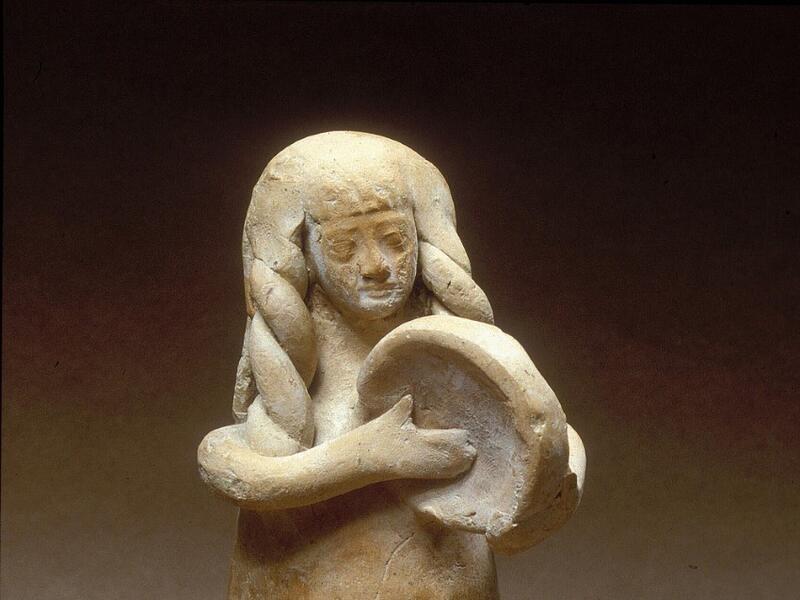From the Archive: Woman Playing Frame Drum
What We Found
Take a look at this approximately four-inch terracotta figurine with a reconstructed base of a woman playing a hand-drum. We might think that, historically, drummers tended to be men. Why might an ancient figurine portray a woman drummer?
This figurine evokes the line in the Torah that describes Miriam celebrating the successful crossing of the Red Sea by playing a drum. The moment after the water consumes Pharaoh’s army, the Israelites march onto dry ground. Exodus 15:20 explains, “Then Miriam the prophet, Aaron’s sister, picked up a hand-drum, and all the women went out after her in dance with hand-drums. And Miriam chanted for them: Sing to God, for God has triumphed gloriously; Horse and driver God has hurled into the sea.” Many Jewish feminists have sought to pay tribute to Miriam and her music-making. For example, Debbie Friedman’s iconic “Miriam’s Song” references Miriam and the women who followed and rejoiced with her “dancing with their timbrels.”
Technically, “timbrel” is a misnomer. This ancient terra-cotta shows a hand-drum or a hand-held version of a frame drum, which has a head that is wider than it is deep. Holding her drum, this lovely figurine invites us to explore the history of biblical women as musicians and drummers. The figurine, featured in The Posen Digital Library, was found in Shikmona, south of Haifa. Though its sculptor is unknown, we can date its creation to the Iron Age, between the ninth and eighth centuries BCE. The drumhead is recessed, indicating that the drum likely only had one head. The figure holds the drum in one hand. She places her other hand flat against the drum as if she has just struck its head. The woman’s eyes, nose, and mouth are carved into a soft expression. Her hair is shaped into thick, twisted, braid-like curls.
Terra-cotta figurines like this one were common in Phoenicia, ancient Israel’s neighbor on the Mediterranean coast, and at sites influenced by Phoenician culture. Archaeologists have discovered them across the Middle East. According to feminist biblical scholar Carol Lyons Meyers, figures of women predominate ceramic renderings of people from Palestine. Meyers suggests that Phoenician colonies established throughout the Mediterranean probably helped facilitate the spread of this style of terra-cotta figurines.
In the ancient world, women were the primary players of frame drums, one of the chief percussive instruments from 3,000 BCE to 500 CE throughout the Middle East and the Mediterranean. Diverse material cultures throughout history often depict women as drummers. Hand-drums, and women as their primary players, followed a similar trajectory to that of the terra-cotta figurines suggested by Meyers. Hand-drums spread from the Middle East through the Mediterranean to what is now Greece around the sixth century BCE. From Greece, the hand-drum became popular in Rome and thus spread throughout the Roman Empire.
Why It Matters
Biblical references to women playing drums suggest that women drummers were common among the Israelites. In addition to the example of Miriam described above, there are other instances in the Torah where women played drums to celebrate military victories. When David returned from battle along with King Saul, for example, 1 Samuel 18:6 notes that “the women of all the towns of Israel came out singing and dancing to greet King Saul with timbrels, shouting, and sistrums.” In the following verse, “The women sang as they danced, and they chanted: Saul has slain his thousands; David, his tens of thousands!”
Meyers argues that the existence of these biblical references and artifacts such as this figurine demonstrate “the existence of a women’s performance genre of drum-dance-song.” She notes that a society’s gender norms shape women’s expressive forms.
The pattern of battle, victory, and celebration (and the creation of an artifact to commemorate this genre of celebration) also demonstrate that women occupied a crucial role in the processes of war, as well as in the worship of God, the source of victory. This type of performance following battle indicates a level of preparedness and expertise among the women who participated. While we don’t know much more about these women, the drum-dance-song genre of music-making was undoubtedly an important part of the lives of some Israelite women and gives us clues about how and with whom some women spent their time.
In light of this history of a women’s performance genre of drum-song-dance, this figurine of a woman playing a hand drum is not at all surprising. In fact, women percussionists, and figurines portraying them, would have been a frequent sight in the ancient world.
Learn More
Check out this previous From the Archive column about another Iron Age figurine, which explores the tensions surrounding figurines and idolatry, the ambiguity of their purpose, and their connection to fertility and reproductive health.
This post is part of JWA’s From the Archive column. It was written in partnership with The Posen Library of Jewish Culture and Civilization.










Hello! Thank you for writing this! For more information about women as the primary percussionists throughout the ancient Mediterranean world, in positions of spiritual leadership, in celebration and ceremony, including the Phoenician influenced area of Ancient Palestine, please see my teacher’s book, “When the Drummers Were Women: a spiritual history of rhythm”. Layne Redmond unearthed all of this vital information. And I can tell that her work has influenced this article. And the sistrum that is mentioned, is a handheld stick with jingles, also used by these ancient women in their processions of ritual and reverie. Later, the jingles ended up on the frame drum, and thus the tambourine was born! Think: Miriam‘s tambourine, the reference to the well of Miriam‘s deep spiritual leadership for her community as they crossed the desert.